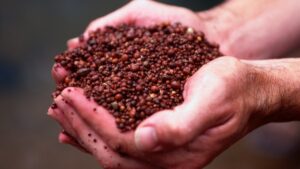Future Battery Minerals confirms outstanding metallurgical results at Big Red

Results indicate that processing of Big Red material via a hybrid flowsheet utilising both DMS and Froth Flotation can produce a high-grade, marketable spodumene concentrate. Pic via Getty Images
- DMS: Heavy Liquid Separation (HLS) undertaken on -3.35mm +850um fraction produced spodumene concentrate grading 5.56% Li2O with a stage recovery of 52.9%.
- XRD results show spodumene is the primary lithium mineral at the Big Red pegmatite
- The Big Red pegmatite is thick and open to the north, with strike extension planned to begin with the upcoming Phase 4 drill program
Special Report: Outstanding metallurgical results demonstrate Big Red is amenable to conventional Dense Media Separation (DMS) and Froth Flotation separation techniques.
Future Battery Minerals (ASX:FBM) has been undertaking a maiden metallurgical testwork program on mineralised material from the Big Red pegmatite within the Kangaroo Hills Lithium Project (KHLP) in WA’s Goldfields.
The aim of the program was to assess the amenability of mineralisation to conventional spodumene separation process techniques, namely Dense Media Separation (DMS) and Fines Froth Flotation.
With Nagrom Laboratories conducting the metallurgical testwork, the company selected five diamond core samples – based on the central proximity within the identified mineralised zones at grades aligning with typical drilling assay results – from the Big Red lithium-mineralised pegmatite.
Composite samples #1 to #4 were used initially to undertake preliminary liberation testwork to determine Heavy Liquid Separation (HLS) performance at alternate crush sizes as well as to develop a preliminary flotation reagent regime and define the deslime and magnetic separation requirements for the fine fractions.
Meanwhile, composite 5 was processed through HLS at a single size fraction, followed by a Whole of Ore (WOO) Fines Flotation test program based on the refined parameters set by the prior testing.
‘Ample opportunity for further optimisation’
According to FBM managing director and CEO Nicholas Rathjen, the results indicate that processing of Big Red material via a hybrid flowsheet utilising both DMS and Froth Flotation can produce a high-grade, marketable spodumene concentrate with low impurity levels at robust recoveries.
XRD data for composite #5 suggested that around 90% of the Li2O is present as spodumene.

“Being only preliminary testing, the results also demonstrate ample opportunity for further optimisation with more refined process evaluation across subsequent metallurgical testwork phases,” Rathjen says.
Further testing and drilling to follow
The next stage of metallurgical testing is set to begin after completion of the upcoming Phase 4 drilling program at the KHLP.
“This drill program will test the interpreted extension of the Big Red mineralisation, as well as other high-potential resistivity targets in the northern part of the project and will also deliver additional, broader, mineralisation samples for the further metallurgical testwork planned for Kangaroo Hills.”
This article was developed in collaboration with Future Battery Minerals, a Stockhead advertiser at the time of publishing.
This article does not constitute financial product advice. You should consider obtaining independent advice before making any financial decisions.
Related Topics

UNLOCK INSIGHTS
Discover the untold stories of emerging ASX stocks.
Daily news and expert analysis, it's free to subscribe.
By proceeding, you confirm you understand that we handle personal information in accordance with our Privacy Policy.








